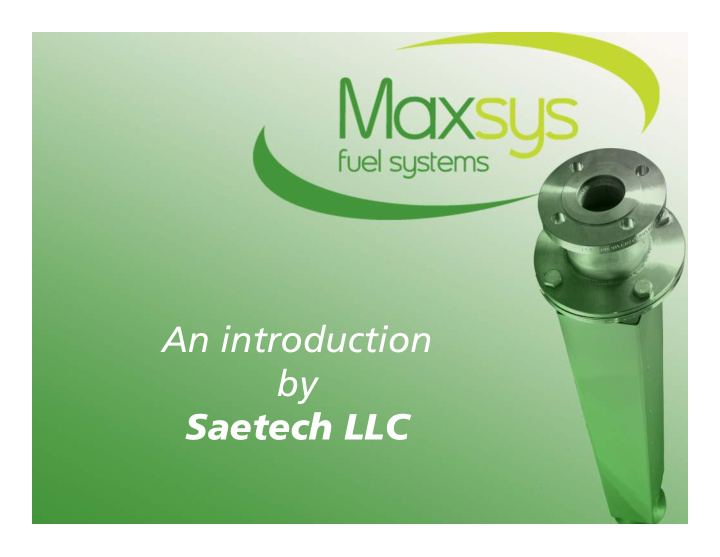



An introduction by Saetech LLC
The opportunity � Annual energy cost savings in excess of 5% � Reduced site emissions and importantly NOx � Improved plant efficiency � Simple implementation, turn key project � Absolutely No commercial risk � Proven technology
Industry sectors • Well known names across all industry sectors benefiting from this proven technology include: – General Motors – Ford Motor Co. Ltd – Dow Chemical Co. – PepsiCo – BMW – Owens Illinois (OI) – Ciba Specialty Chemicals – Michelin – Mondi – Formica – Danone – Imerys – GE Plastics SABIC – SCA Hygiene – Bakels
US owned UK Customers • Selection of existing and ongoing projects with US owned businesses: – PepsiCo – Coca-Cola – Becton Dickinson – Ford Motor Co. Ltd – General Motors – Mondi – Dow Chemical Co. – Constellation – Cabot Corporation – Glatfelter
US owned UK Customers • Selection of existing and ongoing projects with US owned businesses: – Albemarle Corporation – International Paper – Stepan – Master Foods – Huntsman – Cargill – Kellogg's – Kimberley Clark – Owens Illinois – Anglo American – Georgia Pacific – Tensar
Maxsys Fuel Systems in the USA • Exclusive support throughout North America from a dedicated team with world class, global industry experience from their Head Quarters in Salem, Ohio - Saetech LLC
Fuel System Technology • The effect of magnetism on nanoparticles in fuel: ( Images show deposits formed on fire tube wall ) Normal After Maxsys system fitted • Documented effect on the behaviour of nanoparticle size constituents and impurities within the fuel • Especially in respect of their ability to aggregate • Positive effect on heat transfer rates
Effect of aggregated nanoparticles • The finite energy available in the fuel is most efficiently utilised in plant as radiant energy, rather than at the secondary convection and conduction stages. • The aggregated nanoparticles within the fuel produce a more radiant, hotter flame and consequently more complete and efficient use of the energy in the available fuel. The hotter flame also results in a reduction in unburned fuel and more complete destruction of particulates.
After installation, the following effects are always observed • Fuel burned to achieve the same process output reduced by 5% with an opportunity for reductions up to 9% following further optimisation • Reynolds number of the fuel prior to combustion is altered • A hotter, better defined, more blue radiant flame is observed • Flue stack temperature is reduced • Unburned fuel in the flue gas is reduced • Oxygen, CO and particulates in flue gas reduced or eliminated • Concentration of Thermal NOx reduced, despite increased flame temperature, where combustion is below 1,800 ˚ C • Where fouling is a feature of the plant, this is reduced
Reduction of sites emissions • A 5% reduction in fuel burned results in a 5% totalised pro rata reduction in CO 2 , CO, O 2 and particulates. • Combustion plant operating with flame temperatures up to 1800 ˚ C achieve a totalised reduction in NOx of over 5%. • Real benefits observed exceed the above due to the improved combustion, with CO eliminated and O 2 , particulates and unburned fuel dramatically reduced. • The now high level of excess air acts as an effective means of reducing NOx concentration on standard burners and allows low NOx designs such as Bloom, Coen etc. to achieve concentration reductions in line with their design parameters despite increased efficiency.
Techniques recommended by US Environmental Agencies for control of NOx: • Reduce Energy Consumption � Costs you Money! • Substantially increase Excess Air � Costs you Money! • Reduce Residence Time � Costs you Money! • Starve combustion of Excess Air � Costs you Money!
Techniques recommended by US Environmental Agencies for control of NOx: • Reduce Energy Consumption � 5%+ Guaranteed with the Maxsys Fuel System! • Substantially increase Excess Air � Achieved by the Maxsys Fuel System at No Extra Cost! • Reduce Residence Time � Achieved by the Maxsys Fuel System at No Extra Cost! • Starve combustion of Excess Air � Ultra Low NOx burners achieve this even more efficiently with the Maxsys Fuel System at No Extra Cost!
Academic research • Maxsys have commissioned two research programmes - one with the School of Chemical Engineering at Birmingham University and the other with the School of Mathematics at Aston University. • Both programmes are actively supported and sponsored by the EPSRC (Engineering and Physical Sciences Research Council).
Collaborative Research Network in Nanotechnology
The Systems can be applied to a wide range of plant:
Cogen Energia, Tortosa Spain • GE Gas Turbine with Eclipse burner
Typical savings when applied to supplementary firing of Gas Turbine CHP Plant • International Paper: GE Alstom Tornado single shaft gas turbine. Waste heat recovery producing superheated steam (44 barg 400C). Two Maxsys Systems saving 7% • Arjo Wiggins: Gas Turbine CHP driving 10mW generator and feeding waste heat boiler producing steam at 45 tonnes/hr. One Maxsys System saving 9.4%
Fluid Bed Dryer, Ciba Specialty Chemicals
Chemical Industry Feedback “We’ve already verified an 8% saving in the fuel consumption on the steam boiler alone…As for an overall figure for all 3 systems combined – I’m being very conservative and estimated a 5% total saving…. I can’t praise the success of the project highly enough…” Ian Martin, Environmental Manager, Cray Valley Stallingborough, UK. 19
Recommend
More recommend